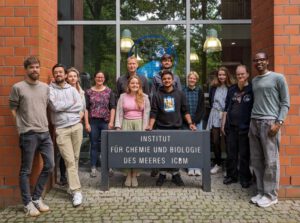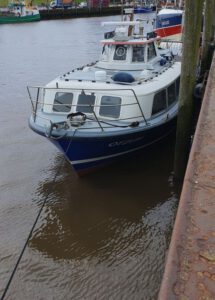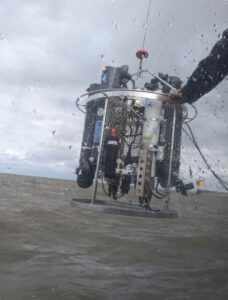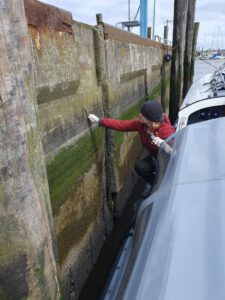From June 10 to June 14, a joint sampling took place at the ICBM in Oldenburg as part of the MultiCultivation project, in which all project partners participated. The aim was to examine water samples from the Wadden Sea south of Spiekeroog. Each project partner contributed their respective expertise in classical cultivation methods as well as molecular and bioinformatic approaches. Overall, the project partners from DLR, ICBM and TZW were able to set up cultivations with different objectives and start measurements. Meanwhile, André and Lea from the UDE analyzed the DNA of environmental samples and enrichments. Thomas (FAU) and Marius (HUB) actively supported the cultivation partners.
The highlight of the week was the sampling, for which we took the research boat Otzum to the Wadden Sea south of Spiekeroog to take seawater samples with a rosette sampler (CTD). We also took water samples from the harbor basin of Neuharlingersiel and the sluice a little upstream, as well as surface sediments from the Janssand sandbank. We were supported by staff from the ICBM’s Marine Sensors working group, who also provided us with background data such as the water temperature from the Spiekeroog measuring station.
The individual project partners pursued different projects, but all aimed to cultivate and research marine bacteria and archaea. Annika from TZW focused on the cultivation of hygienically relevant groups of bacteria such as coliforms and vibrios, as well as cultures for the investigation of antibiotic resistance. Katharina Runzheimer and Katharina Siems from DLR tried to enrich extremophilic, especially halophilic and radioresistant organisms from the water column and the Janssand sediment under different cultivation conditions. Lisa from ICBM took seawater samples to enrich archaea of the previously uncultivated Marine Group II (MGII) from the water column in order to be able to study them in more detail.
We would like to thank everyone for their active participation in this beautiful and very productive week, which, in addition to the work on the multi-cultivation project, also promoted scientific exchange outside of it and laid the foundation for possible further cooperation.




